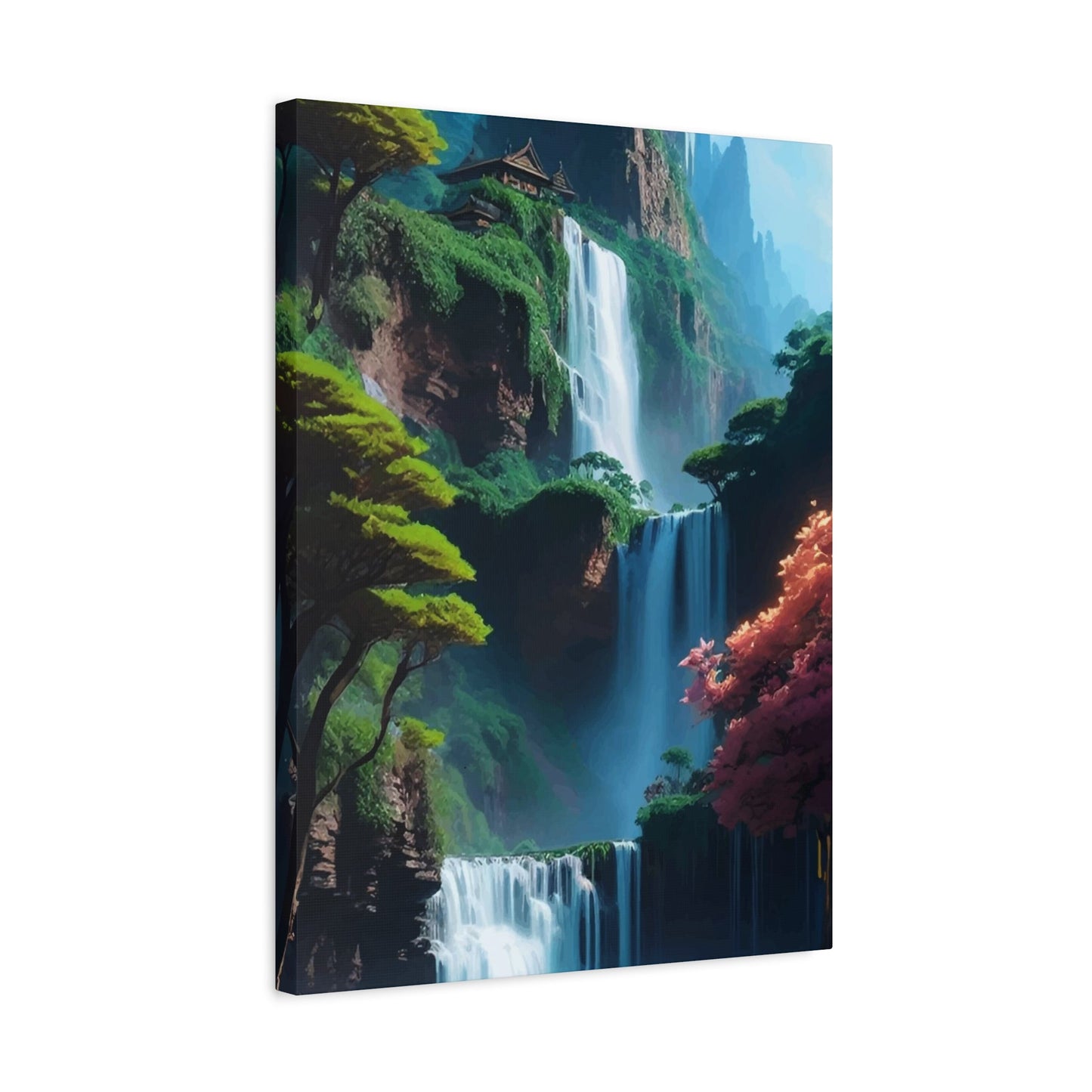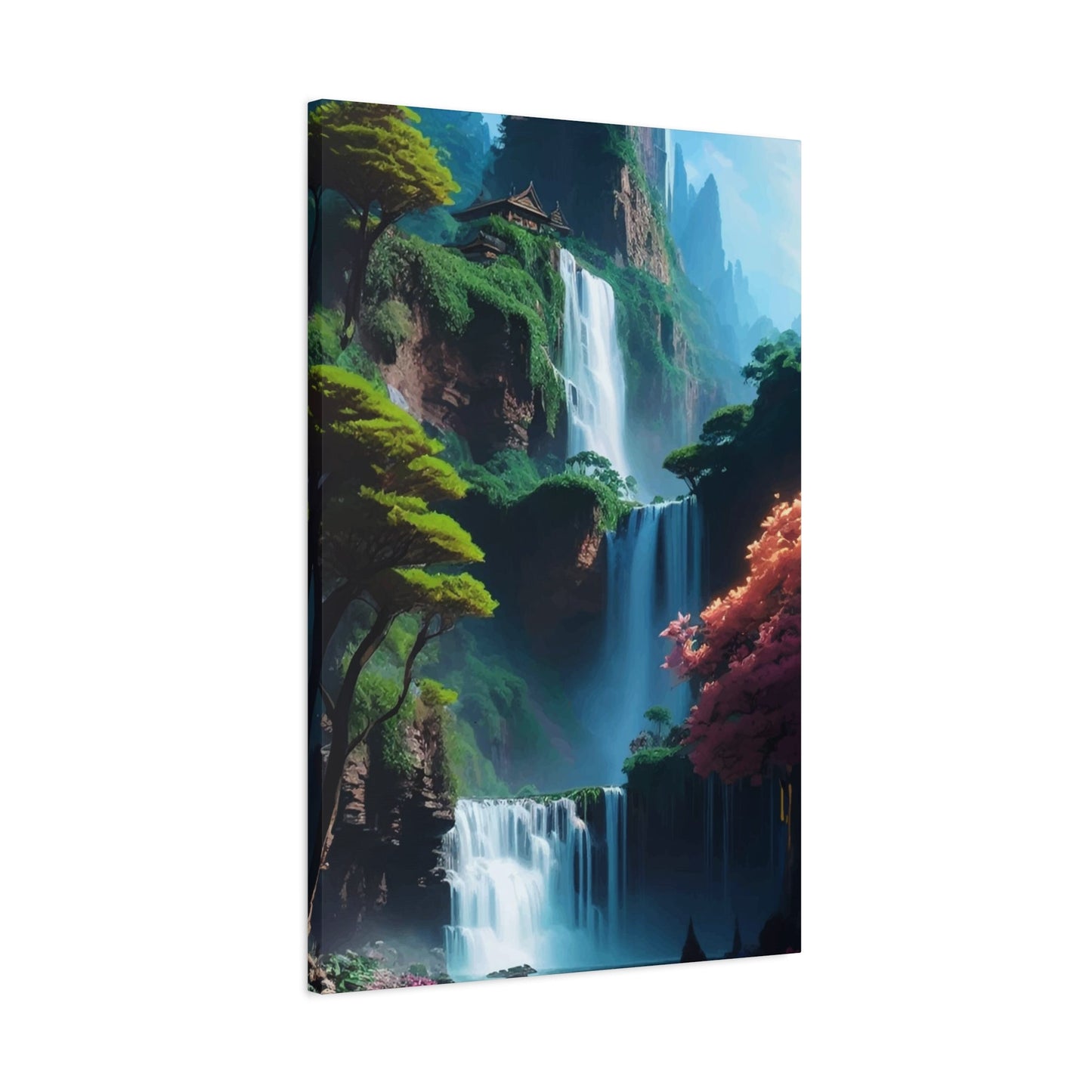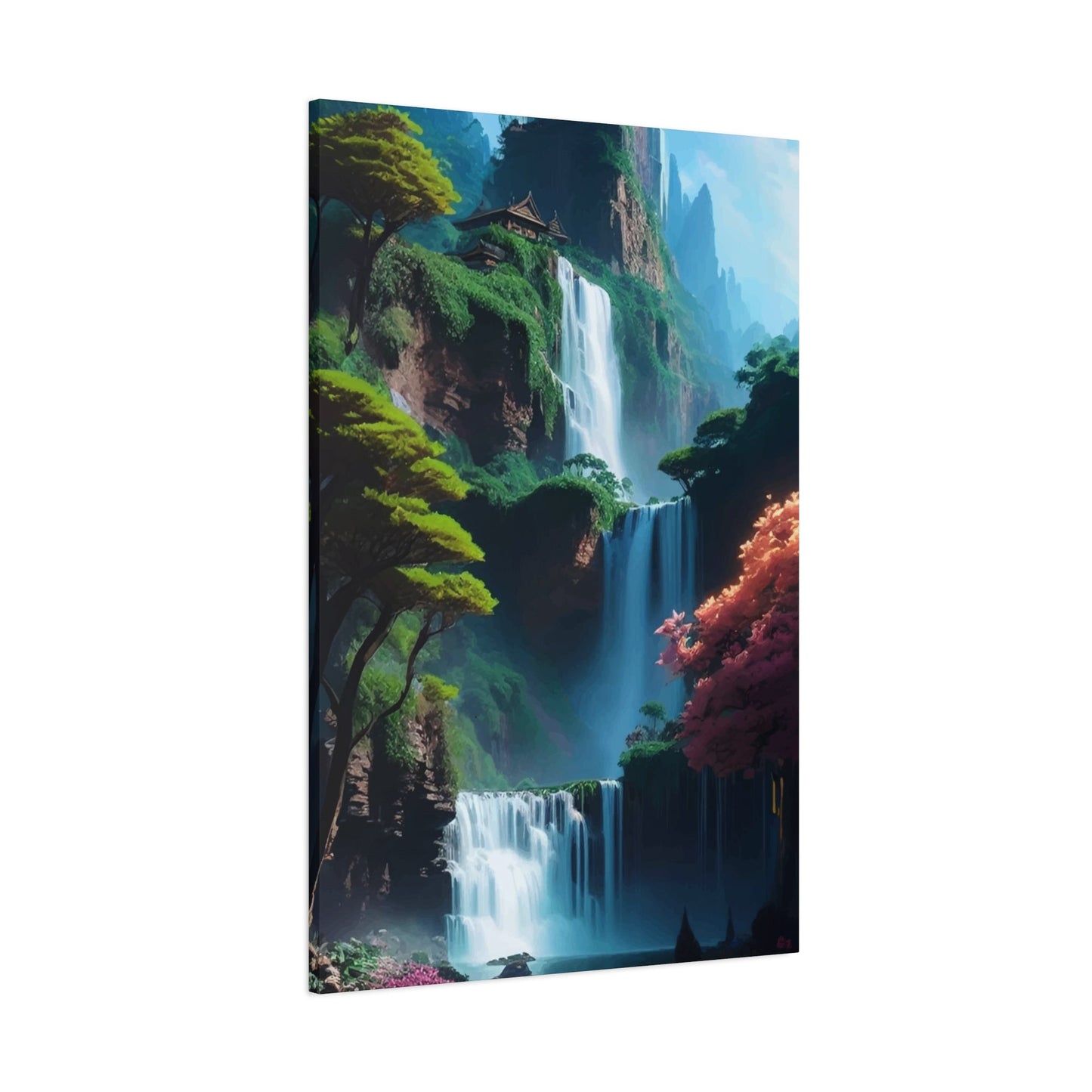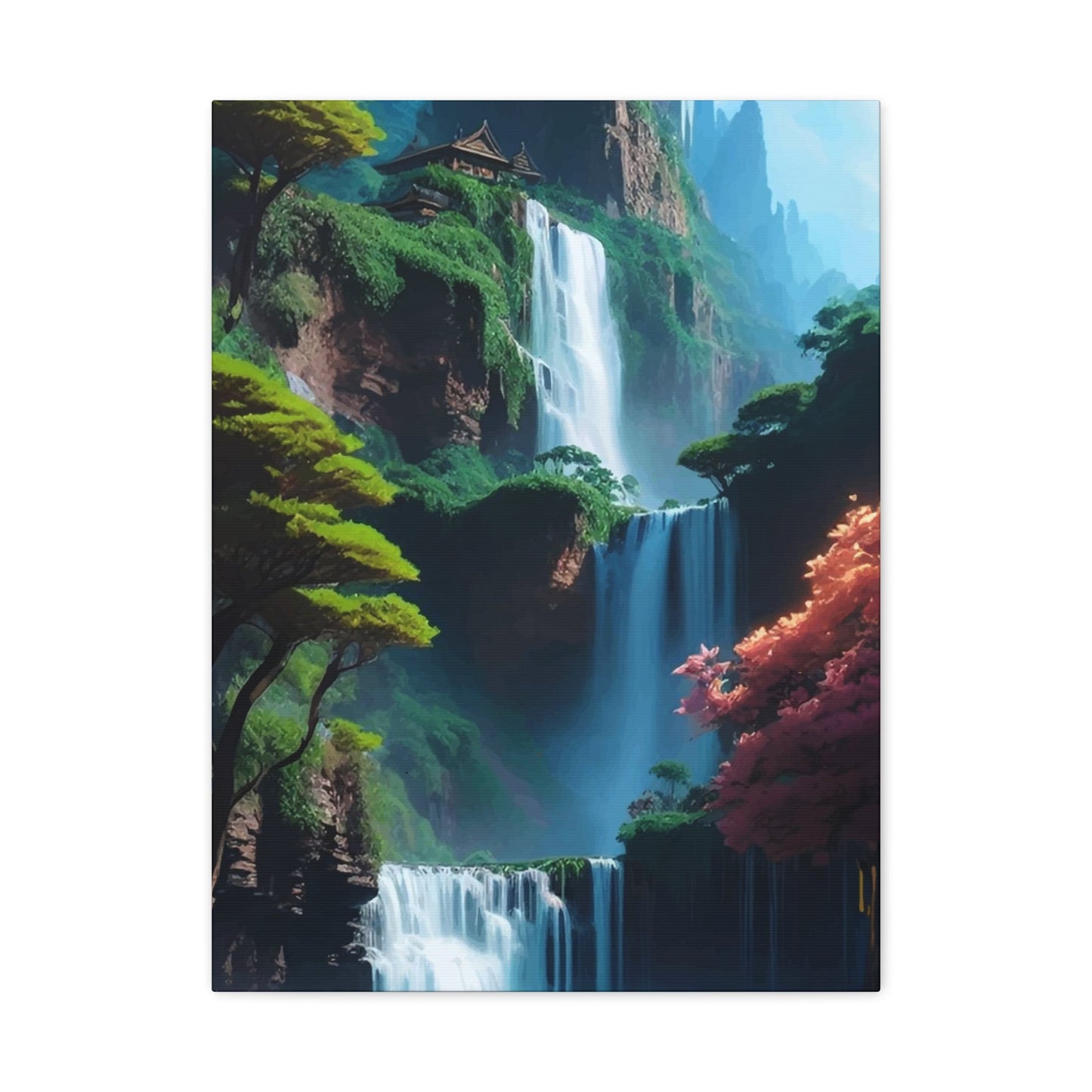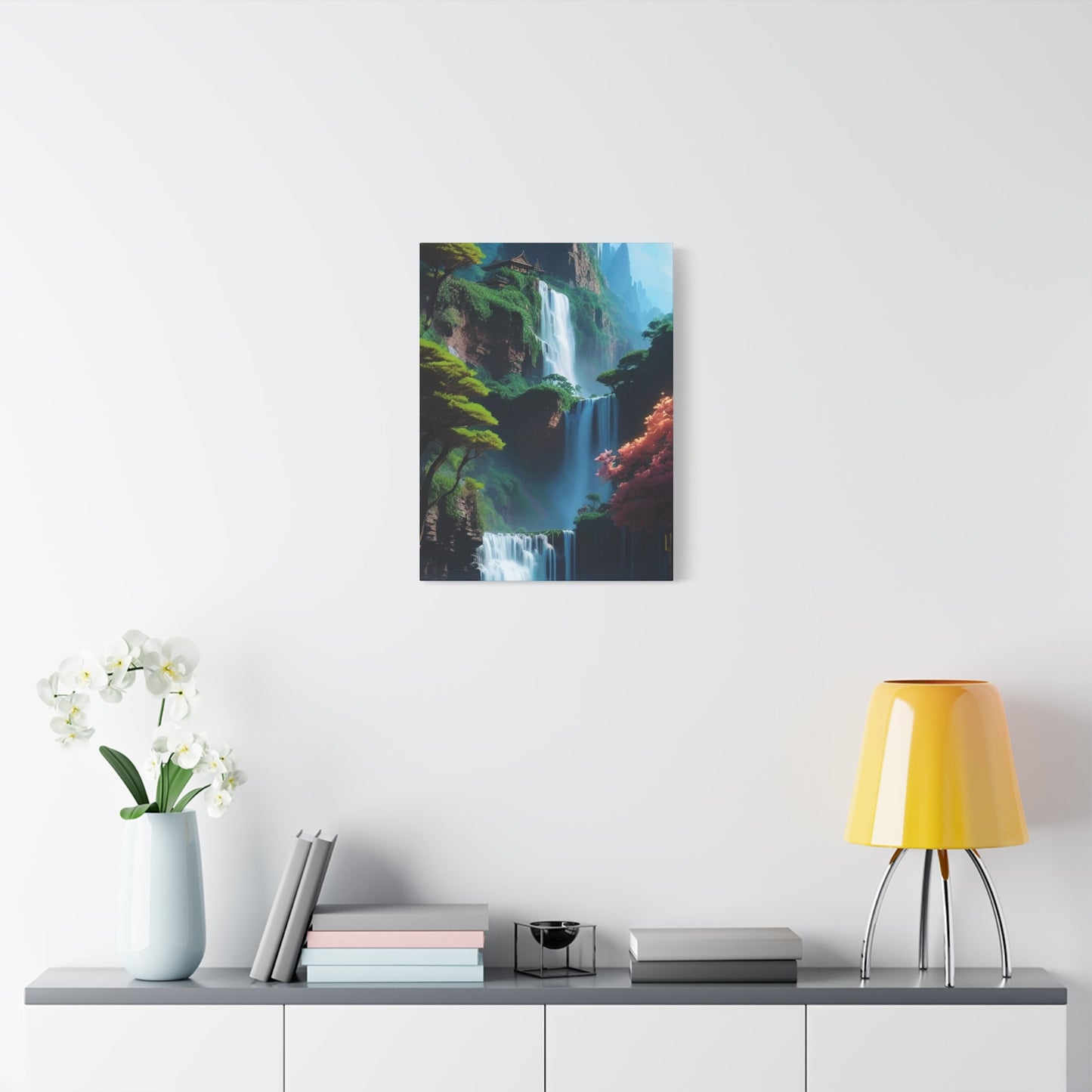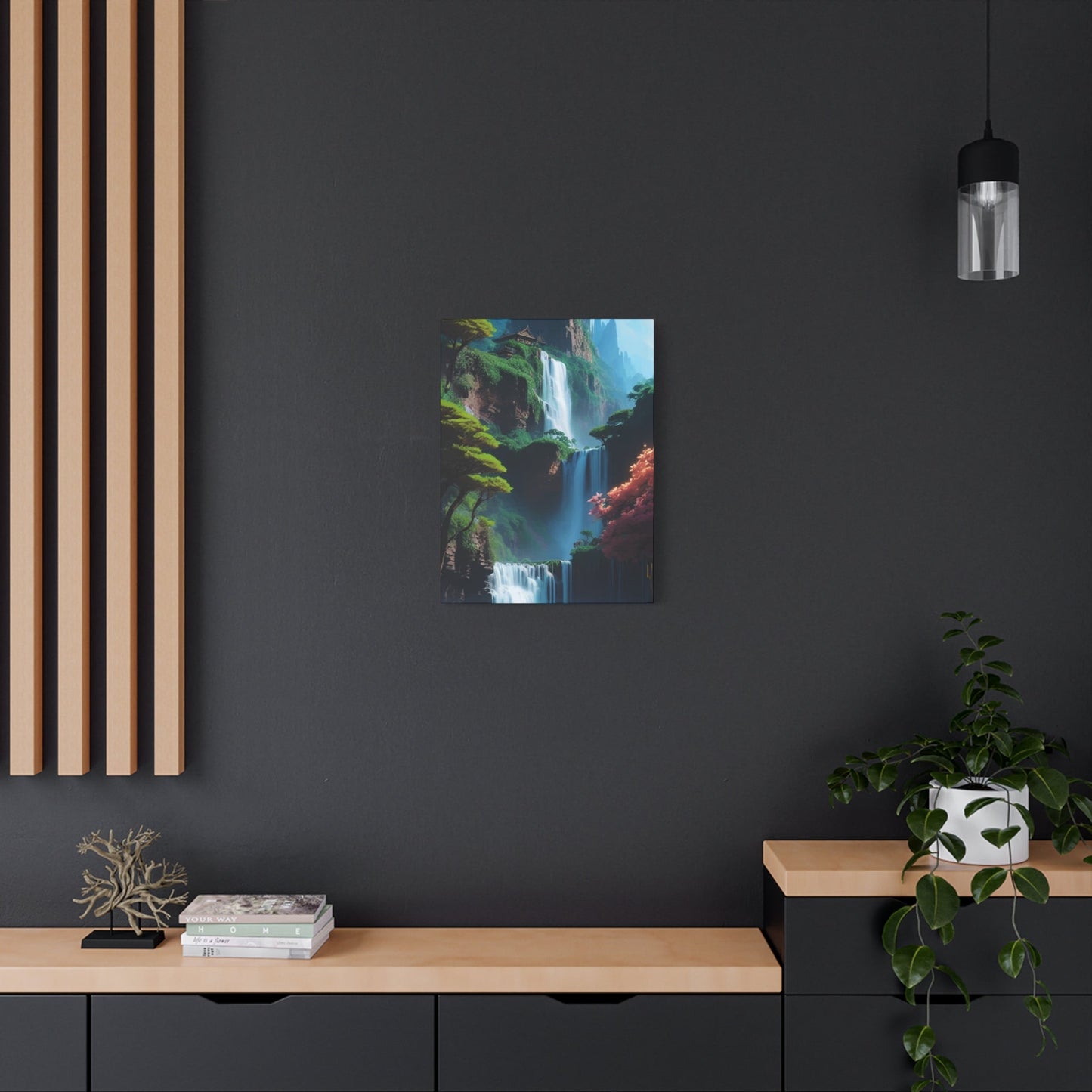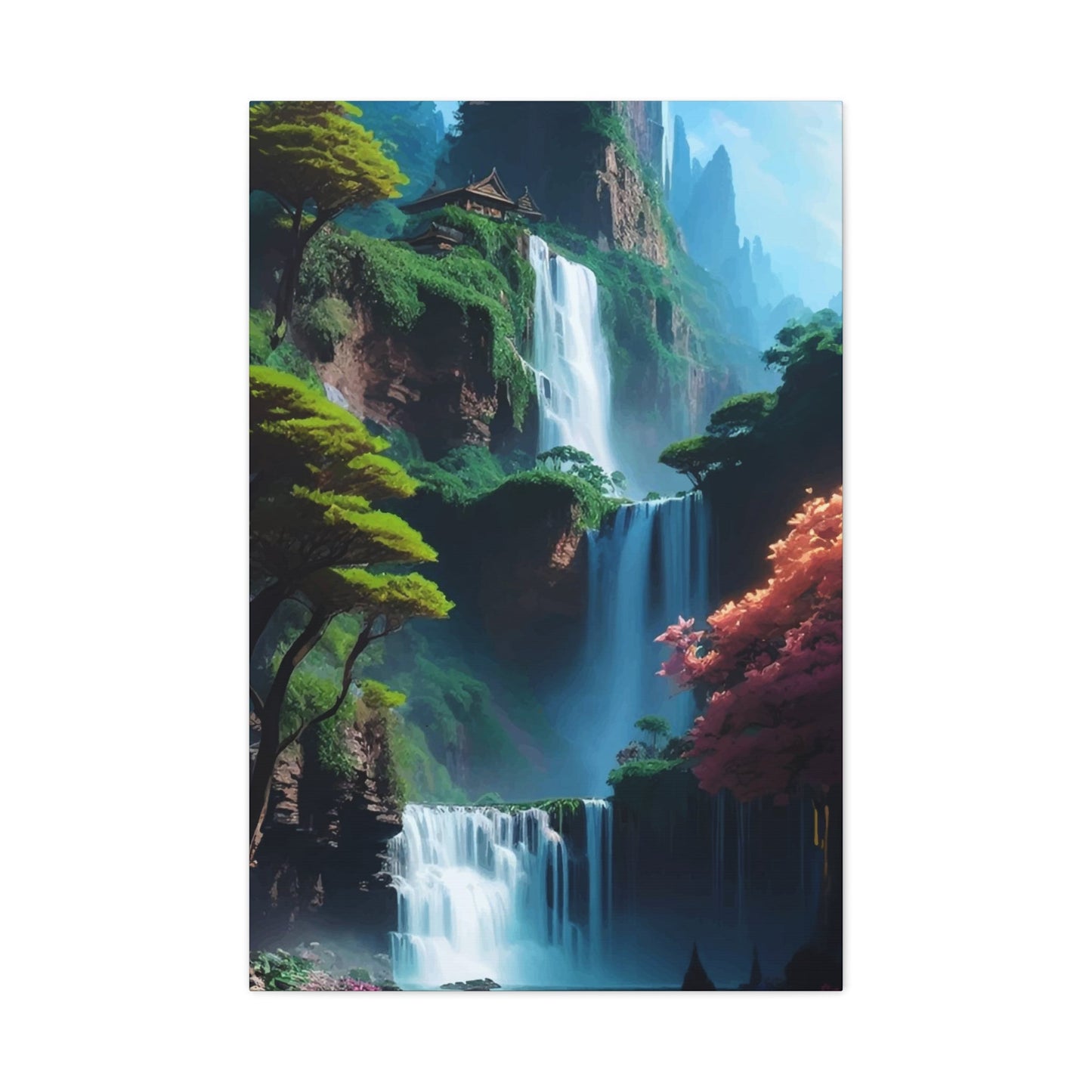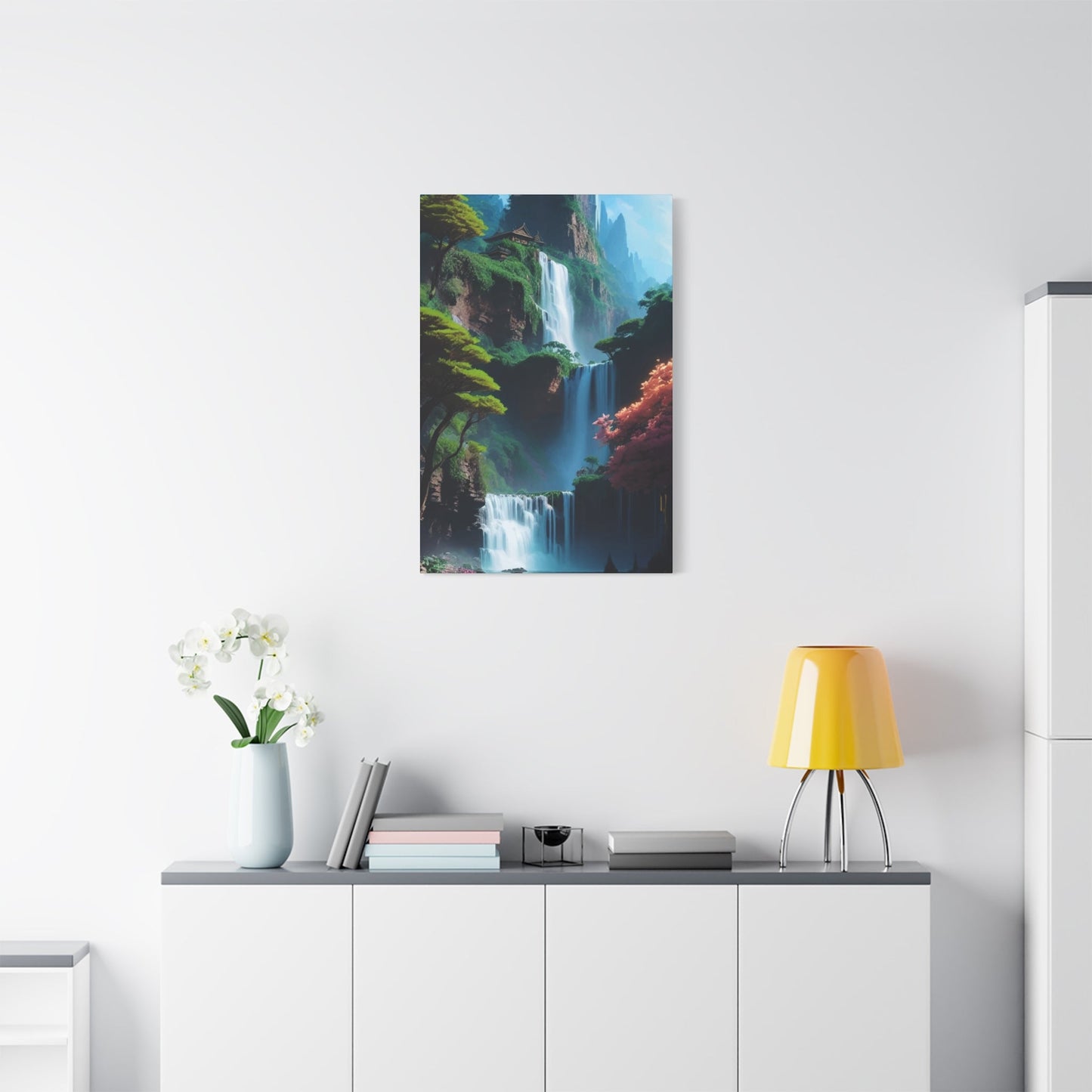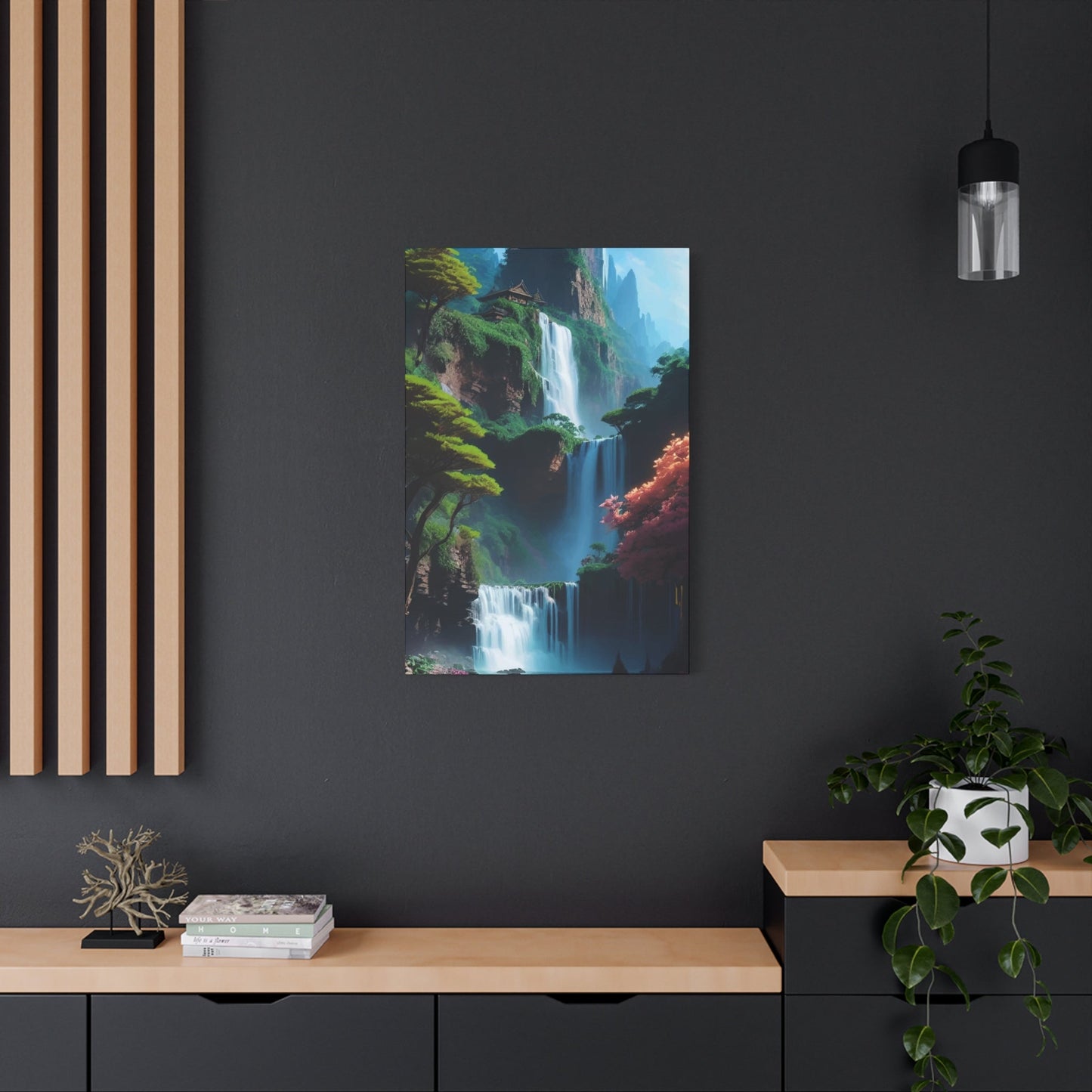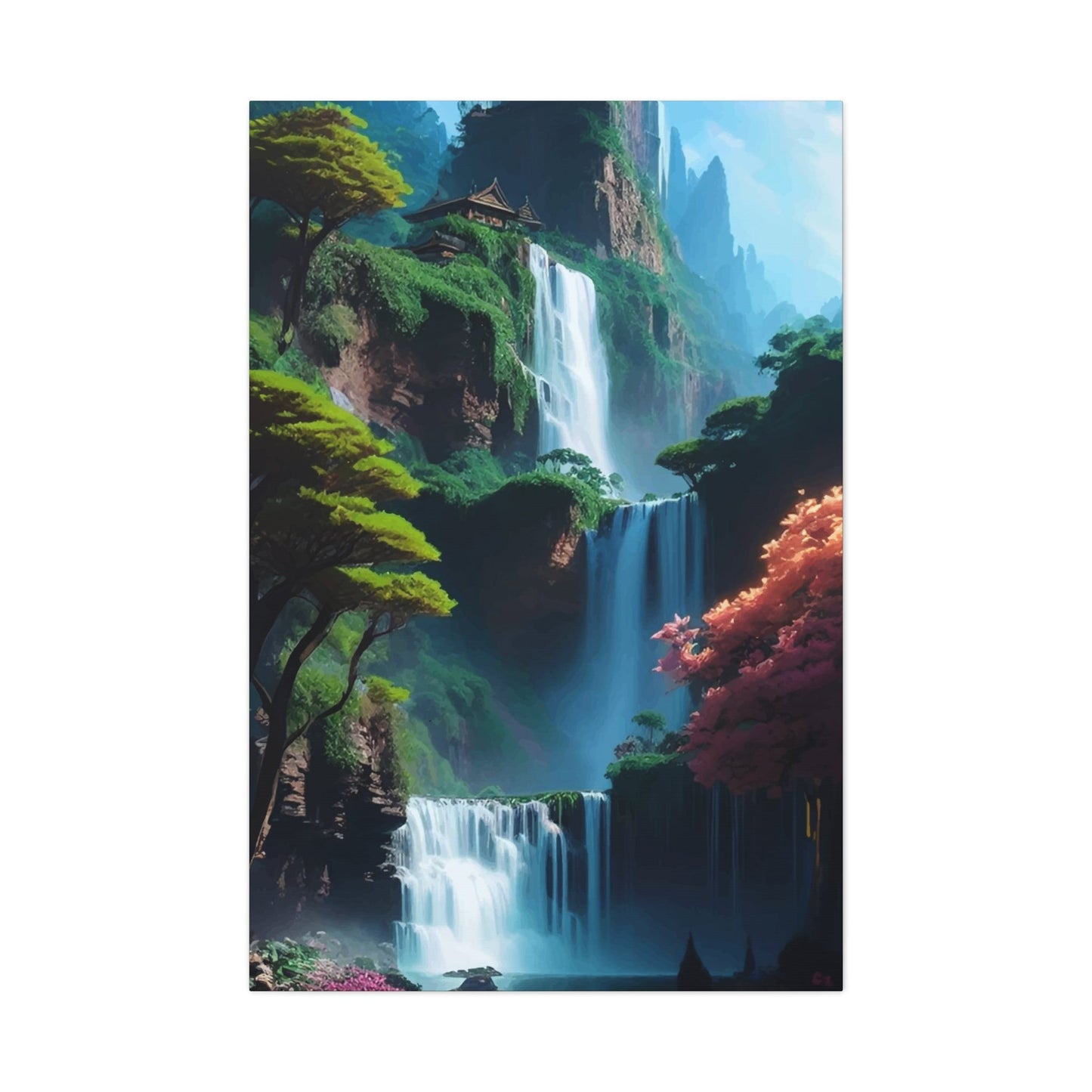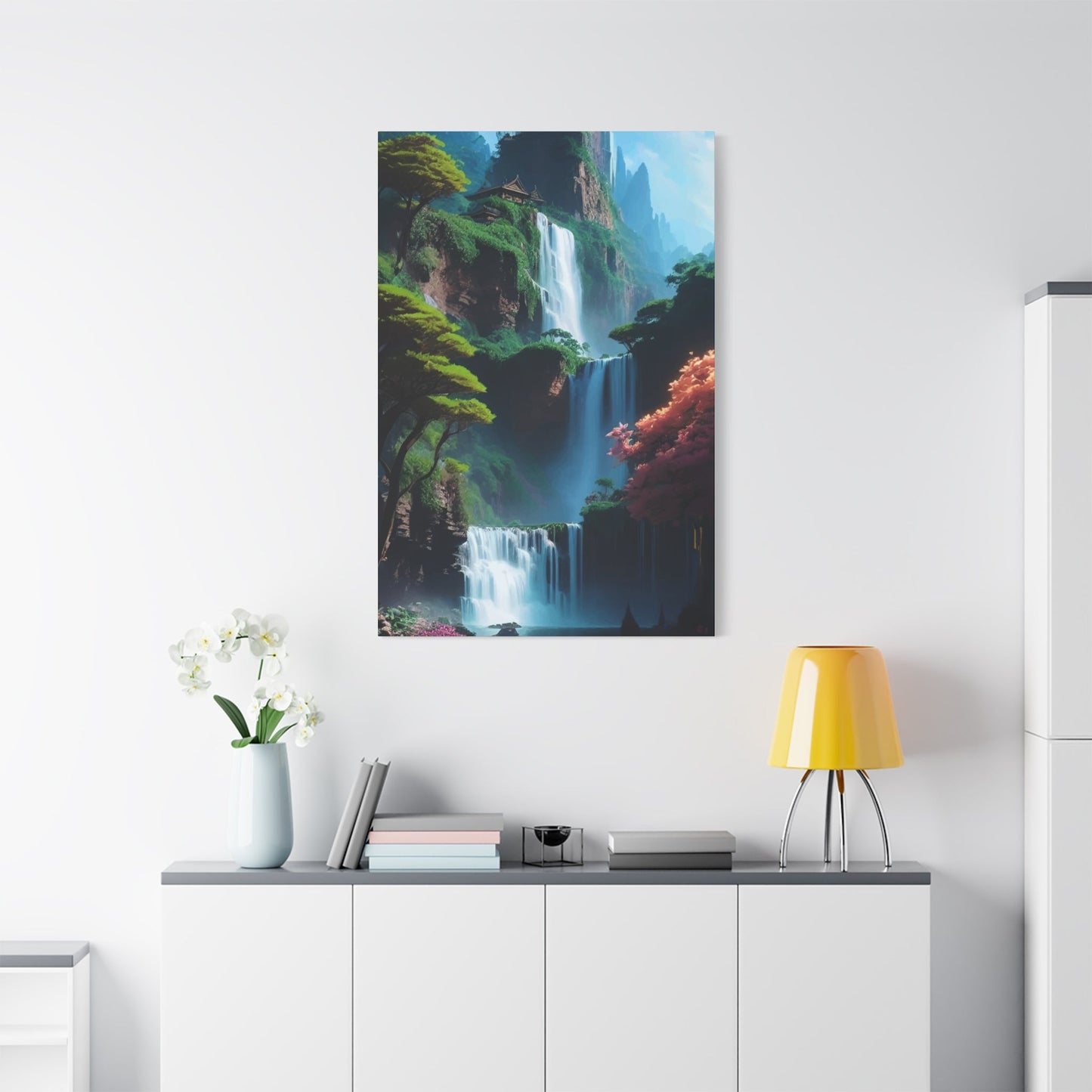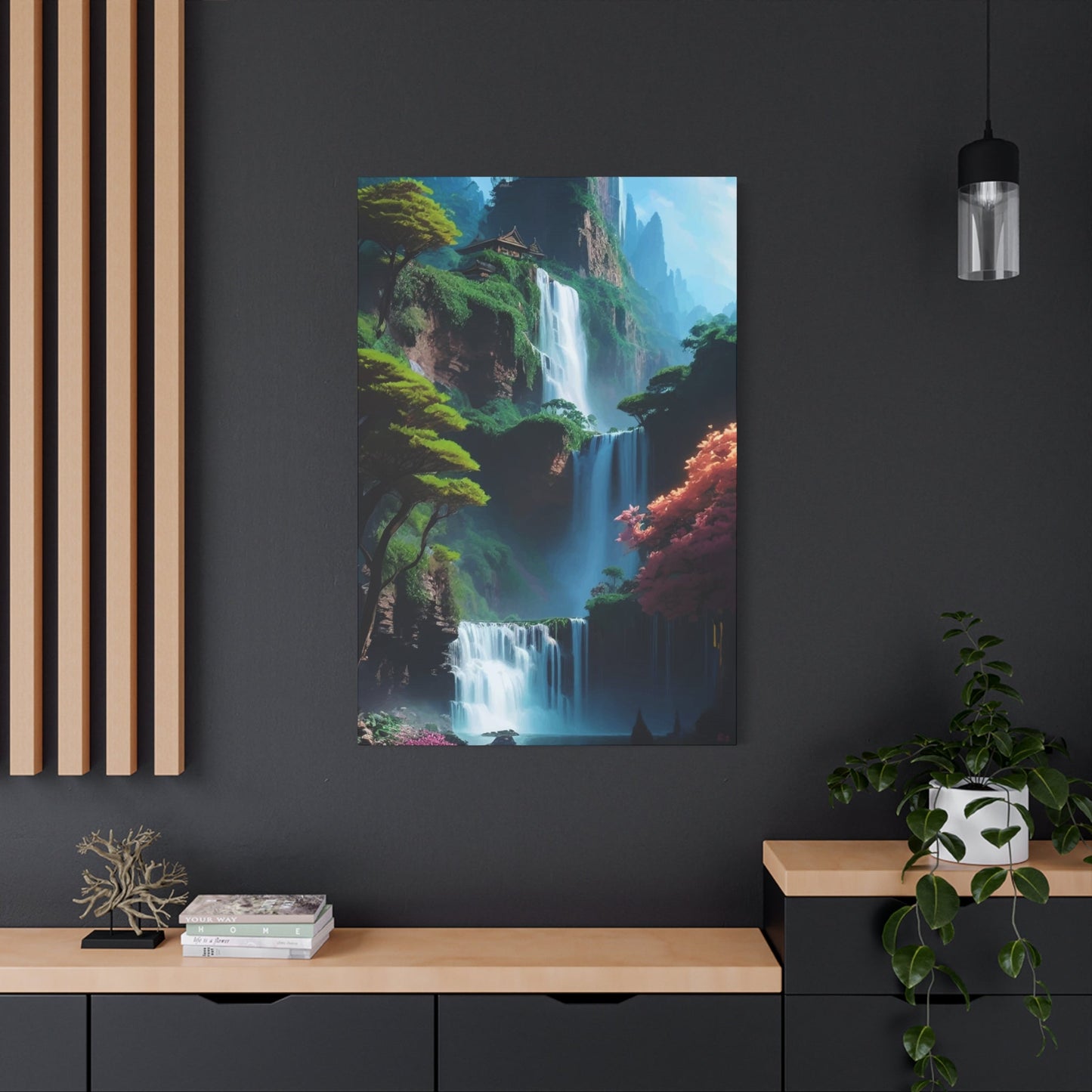Bringing Natural Serenity Into Your Living Space Through Cascading Waterfall Wall Art
The allure of cascading water has captivated humanity for centuries, serving as a source of inspiration, meditation, and tranquility. In contemporary interior design, capturing this natural wonder through artistic representations has become increasingly popular among homeowners and decorators seeking to infuse their environments with calming energy. The visual representation of flowing water on walls creates an immediate connection to nature, transforming ordinary rooms into peaceful sanctuaries that offer respite from the demands of modern life.
When you introduce imagery of cascading waters into your living spaces, you're not merely hanging decorative pieces; you're creating atmospheric shifts that influence mood, productivity, and overall well-being. The therapeutic effects of viewing natural water scenes have been documented extensively, with research indicating that such imagery can lower blood pressure, reduce anxiety levels, and promote mental clarity. These benefits make cascading water artwork particularly valuable in our increasingly digital and disconnected world, where meaningful connections to the natural environment have become rare commodities.
The journey toward selecting the perfect water feature artwork for your home involves understanding various artistic styles, recognizing how different representations affect spatial dynamics, and identifying which pieces resonate with your personal aesthetic while serving functional purposes within your interior design scheme. Whether you gravitate toward photographic realism, impressionistic interpretations, or abstract representations, the marketplace offers countless options that cater to diverse preferences and budgetary considerations.
Peaceful Vibes with Waterfall Wall Art
Creating an atmosphere of tranquility within your home requires thoughtful consideration of every design element, and few decorative choices deliver the immediate calming impact that cascading water imagery provides. The visual representation of water in motion possesses inherent qualities that speak to something fundamental within human consciousness, triggering responses that extend beyond simple aesthetic appreciation into realms of emotional and psychological wellness.
The science behind why water imagery creates peaceful vibes relates directly to evolutionary psychology and our species' historical relationship with water sources. Throughout human history, the presence of water has signaled safety, sustenance, and suitable habitat conditions. Our ancestors gravitated toward water sources for survival, and this deep-seated association remains encoded in our neurological responses. When we view representations of waterfalls and streams, our brains activate reward centers associated with security and contentment, producing subtle but measurable reductions in stress hormones while simultaneously increasing production of mood-enhancing neurochemicals.
Beyond these biological responses, the visual characteristics of cascading water imagery contribute to its calming effects through specific aesthetic properties. The vertical lines created by falling water guide the eye naturally downward, creating a sense of movement that feels fluid rather than jarring. This gentle directional flow contrasts beautifully with the horizontal lines typically found in furniture and architectural elements, adding visual interest without creating tension or discord. The interplay between moving water and surrounding landscape elements within these artworks creates compositional balance that feels inherently harmonious to viewers.
Color psychology plays an equally important role in how cascading water imagery generates peaceful atmospheres. Most water feature artwork incorporates cool color palettes dominated by blues, greens, and neutral earth tones. These hues have been scientifically proven to lower heart rate and blood pressure while promoting feelings of calm and stability. Blue in particular activates the parasympathetic nervous system, which governs relaxation responses, making it an ideal color choice for spaces dedicated to rest and rejuvenation. The green tones typically found in vegetation surrounding water features connect viewers to growth, renewal, and natural vitality.
Top Waterfall Canvases for Your Home
Selecting superior quality cascading water imagery for residential display requires understanding the characteristics that separate exceptional pieces from mediocre offerings. The contemporary marketplace presents overwhelming variety, with options spanning multiple price points, artistic styles, production methods, and quality levels. Navigating this landscape successfully demands knowledge of what constitutes excellence in this specialized niche of decorative art.
Photographic representations of famous water features worldwide consistently rank among the most sought-after options for home display. Images capturing iconic locations bring recognizable natural wonders into living spaces, offering conversation-starting focal points that combine aesthetic beauty with geographic significance. High-resolution photographs of locations like Niagara Falls, Victoria Falls, or Yosemite's spectacular cascades deliver stunning visual impact while connecting homeowners to destinations they may have visited or aspire to experience. The technical quality of these photographic pieces matters enormously, with professional-grade images captured using specialized equipment offering far superior detail, color accuracy, and tonal range compared to amateur snapshots.
Artistic interpretations of cascading water through painting mediums provide alternative approaches that emphasize emotional content and creative vision over literal representation. Impressionistic works that suggest rather than precisely depict water movement allow viewers' imaginations to complete the scene, creating engaging interactive experiences that evolve with repeated viewing. These painted versions often incorporate exaggerated color palettes that enhance mood-setting capabilities, using intensified blues, greens, and complementary accent colors to create powerful atmospheric effects impossible to achieve through straight photography.
Abstract representations of water themes offer the most versatility for integration into contemporary interior design schemes. These pieces distill the essence of flowing water into compositional elements that suggest movement and fluidity without literal representation. Abstract water-themed artwork pairs particularly well with minimalist and modern design aesthetics, where highly realistic imagery might feel incongruous with the overall design philosophy. The interpretive nature of abstract pieces also allows them to complement wider color palettes and style directions, making them safer choices for decorators working with evolving design visions.
Add Calm with a Waterfall Print
Introducing cascading water imagery into living environments represents one of the most effective and accessible methods for reducing ambient stress levels and promoting psychological well-being through environmental design. The deliberate selection and placement of such artwork functions as a form of environmental therapy, leveraging visual stimuli to trigger beneficial physiological and psychological responses in occupants who interact with the spaces regularly.
The mechanism through which water imagery generates calming effects involves multiple sensory and cognitive pathways working in concert. Visual processing of natural scenes activates brain regions associated with attention restoration, a phenomenon where mental fatigue decreases and cognitive resources replenish through exposure to nature or nature representations. Cascading water scenes prove particularly effective for attention restoration because they combine natural elements with gentle implied motion that engages visual attention without requiring effortful cognitive processing. This soft fascination allows executive function systems to rest and recover, producing feelings of mental refreshment that occupants often describe as calming or restorative.
The biophilic design principle underlying the calming effects of water imagery recognizes humans' innate affinity for natural elements and our need for connection with living systems. Modern built environments often severely limit contact with nature, contributing to increased stress, reduced cognitive performance, and diminished well-being. Introducing nature representations through artwork serves as accessible biophilic design implementation, bringing nature indoors for populations unable to regularly access outdoor natural environments. Research demonstrates that even viewing nature imagery produces measurable physiological benefits including reduced blood pressure, lowered cortisol levels, and improved mood states.
Color temperature considerations enhance the calming potential of cascading water prints within interior spaces. Cool-toned imagery dominated by blues and greens naturally creates psychological cooling effects that make environments feel more spacious and less confined. These color qualities prove particularly valuable in smaller rooms where physical space limitations might otherwise create feelings of restriction or claustrophobia. The visual expansion created by cool colors combines with the depth suggested by water scenes to produce impressions of vastness that psychologically counteract spatial constraints.
Strategic placement determines how effectively water imagery delivers calming benefits throughout daily routines. Positioning prints within direct sightlines from stress-generating locations like home offices or kitchen work areas provides immediate visual relief during demanding tasks. The mere presence of calming imagery within peripheral vision creates subconscious associations that moderate stress responses even when artwork isn't being actively viewed. Creating designated relaxation zones anchored by water feature prints establishes spaces specifically programmed for stress reduction and mental restoration, supporting healthy coping mechanisms for managing daily pressures.
Scale appropriateness ensures water imagery achieves intended calming effects rather than creating unintended visual tension. Oversized prints in small spaces can feel overwhelming and produce opposite effects from those desired, while undersized pieces in large areas fail to establish adequate visual presence to affect atmosphere meaningfully. The relationship between artwork dimensions and viewing distance determines optimal sizing, with larger pieces required for spaces where viewers will be positioned farther from walls and smaller works suitable for intimate settings with closer viewing distances.
Nature's Beauty on Your Wall
Celebrating the magnificence of natural landscapes through wall-mounted imagery represents a time-honored tradition that continues evolving with contemporary aesthetics and production technologies. The practice of bringing outdoor beauty indoors through artistic representation satisfies fundamental human needs for connection with living systems while allowing personalization of residential environments through carefully curated selections that reflect individual values and sensibilities.
Natural water features possess timeless appeal that transcends temporary design trends and fleeting aesthetic movements. Unlike imagery tied to specific cultural moments or stylistic periods, cascading water representations maintain relevance across decades because they reference eternal natural phenomena rather than ephemeral human creations. This enduring quality makes nature-focused artwork sound long-term investments that won't require replacement when design fashions shift, unlike trend-driven decorative elements that quickly appear dated.
The diversity within natural water imagery accommodates every conceivable design preference and stylistic direction. Tropical waterfall scenes with lush surrounding vegetation create vacation-inspired atmospheres that transport viewers to exotic locations, while mountain stream imagery evokes rugged outdoor adventure and wilderness exploration. Delicate forest brook representations suggest fairy-tale enchantment and peaceful woodland wandering. Desert oasis water features provide striking contrasts between life-giving water and surrounding arid landscapes. This remarkable variety ensures appropriate options exist for any design vision or thematic direction.
Seasonal characteristics within water imagery allow decorators to introduce temporal variety without complete design overhauls. Spring waterfall scenes featuring blooming flowers and fresh green foliage celebrate renewal and new beginnings. Summer representations with full canopy coverage and clear skies convey abundance and vitality. Autumn water features surrounded by colorful changing leaves acknowledge transition and natural cycles. Winter scenes featuring frozen cascades or streams create dramatic beauty through ice formations. Rotating seasonally appropriate pieces keeps interiors feeling current and connected to natural rhythms occurring beyond walls.
The educational dimension of nature-focused wall art adds value beyond pure aesthetics, particularly in family homes where children benefit from exposure to diverse ecosystems and geographic wonders. Displaying imagery of water features from around the globe introduces young people to environmental diversity while potentially inspiring future travel aspirations and conservation awareness. Conversations sparked by nature artwork create opportunities for discussing geological processes, ecological relationships, and environmental stewardship, transforming decorative elements into teaching tools that support informal learning.
Serenity Starts with Waterfall Art
Establishing peaceful home environments requires intentional design decisions that prioritize psychological comfort and emotional well-being alongside functional requirements and aesthetic preferences. Among available design strategies for creating serene atmospheres, incorporating cascading water imagery stands out for its accessibility, versatility, and proven effectiveness at generating calming environmental conditions that support relaxation and stress reduction.
The foundation of serenity created through water imagery rests on evolutionary adaptations that predispose humans to respond positively to certain environmental features. Natural water sources throughout human evolutionary history signaled favorable conditions for survival, creating deep neurological associations between water presence and safety. These ancient connections persist in modern brains, meaning that even representations of water trigger subtle comfort responses that contribute to feelings of security and contentment essential for true serenity.
Visual rhythm established through cascading water imagery contributes significantly to its serenity-inducing properties. The implied downward flow creates gentle directional movement that guides viewer attention in soothing patterns lacking the jarring quality of more chaotic compositions. This rhythmic visual flow produces effects analogous to listening to gentle music or watching waves, where repetitive patterns without exact repetition engage attention while promoting relaxation through their predictability and natural pacing.
Best Waterfall Wall Décor Ideas
Implementing cascading water imagery within residential interiors offers countless creative possibilities that extend far beyond simple centered wall hangings. Innovative display strategies, unexpected placement locations, and thoughtful integration with complementary design elements transform standard decorating approaches into personalized artistic statements that reflect individual creativity while maximizing the atmospheric impact of selected pieces.
Gallery wall configurations featuring multiple water-themed pieces create dynamic focal points that combine visual impact with storytelling capabilities. Arranging collections of smaller prints in geometric patterns generates contemporary aesthetics that feel intentional and curated rather than haphazard. Mixing water imagery with complementary nature subjects like forests, mountains, or wildlife creates thematic cohesion while adding variety that keeps displays visually interesting. Incorporating varied frame styles and finishes within unified color palettes produces eclectic sophistication that bridges traditional and contemporary design sensibilities.
Oversized statement pieces deployed in prominent locations make bold design declarations that immediately establish atmospheric tones for entire spaces. Positioning dramatic large-scale water imagery on main focal walls in living rooms or master bedrooms creates anchoring elements around which all other design decisions revolve. The powerful presence of substantial artwork eliminates needs for additional wall decoration in immediate vicinity, embracing minimalist principles that prevent visual clutter while ensuring featured pieces receive undivided attention they deserve.
Unexpected placement locations generate surprise and delight while solving decorating challenges in overlooked or awkward spaces. Installing water imagery above tall furniture pieces like bookshelves or cabinets utilizes vertical space typically left bare while creating visual interest at elevated sight lines. Positioning artwork in hallways and transitional zones transforms utilitarian pass-through areas into meaningful spaces worthy of pause and appreciation. Displaying pieces in bathrooms creates thematic consistency with water-focused rooms while adding sophistication to spaces often treated as purely functional.
Layered display techniques combining water imagery with dimensional objects create depth and visual complexity that elevate standard flat-wall presentations. Positioning sculptural elements on shelves or consoles below waterfall prints establishes vertical relationships between two- and three-dimensional art forms. Incorporating plants near water imagery reinforces nature themes while adding living elements that complement static representations. Placing natural material objects like river rocks, driftwood, or crystals near waterfall artwork creates cohesive nature-inspired vignettes that feel thoughtfully composed.
Create a Zen Room with Waterfall Prints
Establishing dedicated meditation and relaxation spaces within homes provides invaluable retreats from daily stresses and demands. Zen-inspired room design emphasizes simplicity, natural elements, and carefully selected focal points that support contemplative practices and mental stillness. Cascading water imagery serves as ideal anchoring elements for such spaces, combining visual appeal with psychological properties that enhance meditative states and promote deep relaxation.
Zen aesthetic principles prioritizing minimalism and essentialism inform appropriate selection criteria for water imagery destined for meditation spaces. Overly busy compositions with excessive detail or competing focal points work against the mental stillness that Zen environments aim to support. Instead, simplified representations featuring strong but uncomplicated compositions allow viewers to engage without cognitive overload. Negative space within artwork provides visual resting places that mirror the mental spaciousness meditation practices cultivate, creating harmony between environmental design and contemplative intentions.
Color palette restraint characterizes successful Zen room implementations, with monochromatic or limited color schemes preventing visual distraction that interferes with mental focus. Black and white water imagery offers sophisticated elegance while stripping away color considerations entirely, allowing viewers to engage with form, light, and shadow without chromatic distraction. Muted earth-tone renderings in beiges, grays, and soft greens maintain connection to nature while exercising color discipline that supports rather than disrupts meditative focus.
Positioning considerations for meditation space water imagery differ from standard decorating approaches because viewing circumstances and purposes vary significantly from typical living areas. Placing artwork at eye level for seated meditation positions ensures comfortable viewing during practice sessions without requiring neck strain or uncomfortable postures. Installing pieces directly opposite primary meditation positions creates focal points that gently hold attention without demanding it, supporting concentration techniques while preventing mind-wandering that derails meditation attempts.
Bold Spaces Need Waterfall Canvases
Dynamic, energetic interior environments require artwork that matches their confidence and visual intensity rather than shrinking from bold design commitments. Cascading water imagery offers surprising versatility for dramatic spaces, with certain styles and presentation methods delivering powerful visual impact that complements rather than conflicts with adventurous design choices. Understanding how to select and deploy water-themed artwork in bold settings ensures these pieces enhance rather than undermine overall design visions.
Large-scale installations create commanding presence suitable for spaces featuring high ceilings, expansive walls, or dramatic architectural elements. Oversized water imagery measuring five feet or larger in any dimension makes definitive statements that anchor bold interiors while providing visual weight proportional to room volumes. Multi-panel installations spanning entire walls transform architecture through art, blurring boundaries between decoration and integral design features. The immersive quality of substantial water imagery creates environments where artwork doesn't merely hang on walls but fundamentally defines spatial character.
High-contrast black and white water photography delivers graphic punch that complements bold color schemes without introducing competing chromatic elements. The stark drama of monochrome imagery featuring bright highlights against deep shadows creates striking visual impact that holds its own in rooms featuring saturated wall colors or vivid furniture selections. Stripped of color distraction, monochrome water prints emphasize form, texture, and composition in ways that feel modern and sophisticated while maintaining connection to timeless photographic traditions.
Unusual perspective choices separate distinctive water imagery from conventional representations, offering fresh viewpoints that surprise and engage viewers accustomed to standard scenic compositions. Aerial drone photography capturing water features from directly above creates abstract pattern-focused images that emphasize design elements over literal representation. Extreme close-ups isolating water droplets or foam patterns transform familiar subjects into unrecognizable textures that function almost as abstract art while maintaining nature connections. Long-exposure techniques that blur water into silk-like flows or ghostly veils create ethereal effects that suggest movement and time passage through visual metaphor.
Unexpected color treatments push water imagery beyond natural representation into more stylized artistic territory appropriate for bold design contexts. Infrared photography rendering foliage in pink or red tones while maintaining blue water creates surreal color relationships that challenge expectations. Digital color manipulation creating sunset-inspired palettes or jewel-tone saturations transforms familiar water scenes into fantasy landscapes that complement adventurous interior color schemes. Split-toning techniques applying different color casts to highlights and shadows generate sophisticated vintage effects that bridge past and present aesthetics.
Metal print substrates deliver contemporary edge particularly suited to bold modern and industrial-style interiors. The luminous quality and reflective surface of metal prints makes colors appear more saturated and creates depth that draws viewers into imagery. The frameless presentation typical of metal prints emphasizes clean lines and modern sensibilities while allowing artwork to float on walls with minimal visual interruption. Durability and fade resistance of quality metal prints ensures long-term performance appropriate for high-traffic areas where bold design statements receive maximum visibility.
Waterfall Art for Bedroom Tranquility
Bedroom environments serve as personal sanctuaries dedicated to rest, intimacy, and rejuvenation, making them ideal locations for cascading water imagery that supports these essential functions through visual tranquility and psychological comfort. The unique purposes bedrooms serve demand thoughtful artwork selection and placement strategies that differ meaningfully from public living areas, with emphasis on promoting relaxation, supporting sleep quality, and creating atmospheres conducive to intimate connection.
Sleep science research demonstrates that environmental factors significantly influence sleep quality and duration, with visual stimuli present in bedrooms affecting subconscious processing even during sleep. Calming nature imagery reduces ambient stress perception and may contribute to improved sleep onset and maintenance through associations with safe, peaceful environments. The cool color temperatures predominant in water imagery support circadian rhythm regulation by not artificially stimulating alertness the way warmer colors or bright lighting can, making them particularly appropriate for spaces dedicated primarily to sleep.
Positioning water artwork opposite beds creates focal points visible from primary rest positions, allowing restful viewing during wakeful periods while supporting meditation and visualization practices many people employ as sleep preparation. This placement ensures artwork remains prominent within spaces where time is spent in varied body positions, unlike standing-focused viewing in other rooms. However, some sleep specialists recommend avoiding complex imagery directly in sleeping sight lines to prevent visual stimulation that interferes with sleep onset, suggesting placement on walls perpendicular to beds might serve some individuals better.
Size appropriateness in bedroom water imagery balances visual impact against potential overwhelm in intimate spaces. Moderately scaled pieces measuring three to four feet in longest dimension typically provide optimal presence without dominating smaller bedroom environments that benefit from maintaining somewhat human scale. Oversized drama appropriate for public spaces may feel oppressive in private quarters, while undersized pieces fail to establish meaningful presence. The goal involves creating noticeable focal points that attract positive attention without demanding it.
Color coordination between bedroom water artwork and existing palette selections creates harmonious environments that feel cohesive and thoughtfully designed. Pulling bedding colors from artwork tones establishes clear visual relationships that tie together otherwise separate elements. Coordinating wall paint with background tones from water imagery creates seamless integration rather than jarring contrast. Limiting accent color variety throughout entire room prevents visual chaos that undermines the restful simplicity bedrooms should embody.
Bring the Outdoors In with Waterfall Art
Biophilic design principles recognize fundamental human needs for connection with natural world and living systems, needs frequently unmet in contemporary built environments that isolate occupants from outdoor experiences. Incorporating nature imagery represents accessible, practical biophilic design implementation that brings meaningful outdoor connections into interior spaces regardless of building location, climate conditions, or residents' physical abilities to access natural environments directly.
The health benefits associated with nature connection extend beyond psychological comfort into measurable physiological improvements across multiple body systems. Regular exposure to nature or nature representations correlates with reduced inflammation markers, improved immune function, accelerated healing from injuries or surgeries, and better cardiovascular health outcomes. These benefits accumulate through consistent exposure over time, making permanently installed nature imagery valuable long-term health investments rather than merely decorative indulgences.
Cascading water imagery proves particularly effective for indoor nature connection because water features rank among most universally positive natural elements across human cultures. Unlike some landscape features that carry culturally specific meanings or associations, flowing water generally signifies life, abundance, and favorable environmental conditions across diverse cultural contexts. This universality makes water-themed art safe choices for homes housing people from various cultural backgrounds or for designers uncertain about clients' specific nature preferences.
Seasonal disconnect between indoor and outdoor environments becomes increasingly problematic as climate change intensifies weather extremes and reduces comfortable outdoor time. Bringing nature indoors through permanent artwork maintains year-round nature connection regardless of whether outdoor conditions permit comfortable outside time. During extreme heat, cold, air quality emergencies, or severe weather events, interior nature imagery provides psychological refuge and maintained biophilic benefits when outdoor access becomes impossible or inadvisable.
Urban and suburban residents face particular challenges maintaining adequate nature contact due to limited green space access and built environment domination in densely developed areas. For city dwellers unable to regularly visit parks, forests, or natural water features, indoor nature imagery assumes elevated importance as primary nature connection source. High-quality water feature artwork can partially substitute for direct nature experiences, delivering meaningful psychological benefits even when outdoor wilderness access remains impractical.
Waterfall Canvas for Modern Interiors
Contemporary interior design emphasizes clean lines, minimal ornamentation, open space planning, and carefully curated decorative elements that serve clear purposes within overall design visions. Successfully incorporating cascading water imagery into modern contexts requires understanding how traditional nature subjects can adapt to contemporary aesthetic sensibilities without compromising either natural beauty or modern design principles.
Minimalist interpretation of water subjects aligns naturally with modern design values prioritizing essentialism and edited presentations. Simplified compositions focusing on core elements rather than excessive detail create clean, uncluttered imagery appropriate for spaces embracing similar visual restraint. Strong geometric compositions within water photography or painting provide structural clarity that resonates with modern architecture's emphasis on clear form definition. Negative space within artwork mirrors the breathing room modern interiors maintain through strategic furniture placement and limited accessory use.
Monochromatic water imagery offers sophisticated solutions for modern interiors where color restraint maintains visual calm and prevents sensory overload. Black and white photography emphasizing dramatic contrast creates striking focal points without introducing chromatic complexity that might conflict with existing palette selections. Grayscale renderings maintain focus on form, texture, and composition rather than color relationships, aligning with modern design's frequent emphasis on shape and material over decorative color application.
Large-scale installations suit modern spaces characterized by generous proportions and bold architectural gestures. Contemporary homes often feature expansive walls uninterrupted by traditional molding or architectural detail, creating ideal canvases for substantial artwork that would overwhelm traditionally proportioned rooms. Oversized water imagery provides visual weight proportional to modern spaces while maintaining human-scale reference points through recognizable natural subjects that prevent environments from feeling cold or institutional.
Frameless presentation methods align with modern preferences for clean, uninterrupted visual flow. Gallery-wrapped pieces where imagery continues around edges eliminate frame perimeters that can feel fussy or traditional in contemporary contexts. Float mounting that suspends artwork slightly forward from wall surfaces creates subtle shadow lines adding dimensional interest without requiring decorative frames. Standoff mounting using hardware that holds pieces several inches from walls produces even more dramatic floating effects particularly suited to modern metal or acrylic prints.
Metal and acrylic substrates deliver contemporary aesthetic sensibilities that canvas cannot match for certain modern applications. The industrial character of metal prints resonates with modern interiors featuring exposed structural elements, concrete surfaces, or minimal ornamentation. Acrylic's glass-like transparency and depth creates premium presentation quality appropriate for high-end modern homes where material quality signals investment in excellence. Both materials offer practical benefits including superior durability and easier cleaning compared to traditional canvas.
Waterfall Photography Prints You'll Love
The specialized niche of water feature photography encompasses remarkable diversity spanning technical approaches, artistic interpretations, geographical subjects, and presentation styles. Understanding the range of available options helps consumers identify pieces matching personal preferences while appreciating the skill and artistry distinguishing exceptional work from amateur snapshots.
Long-exposure techniques creating silk-like water blur represent perhaps the most recognizable stylistic approach within waterfall photography. By using slow shutter speeds ranging from fractions of seconds to several minutes, photographers capture water motion as smooth, ethereal flows contrasting sharply with static surrounding landscape elements. This technique requires technical proficiency including tripod use, neutral density filtration, and precise exposure calculation. The dreamlike results transform familiar subjects into magical scenes that emphasize movement and time passage through visual metaphor.
Freeze-motion photography captures individual water droplets and splash details invisible to naked eyes, revealing hidden beauty within cascading water's chaotic movement. High-speed flash systems or extremely fast shutter speeds stop motion completely, creating crystalline clarity showing water's sculptural qualities. This approach emphasizes texture and form over flow, producing dynamic images with explosive energy quite different from long-exposure serenity. The technical demands include sophisticated lighting equipment and precise timing making such images relatively rare and valuable.
Golden hour photography capitalizing on warm sunrise or sunset light creates emotionally resonant images with glowing color palettes. The directional quality of low-angle sunlight reveals landscape textures and creates dramatic shadows adding depth and dimension. Warm color temperatures from golden hour light generate cozy, welcoming feelings contrasting with potentially cold associations of water imagery. Timing challenges and weather dependencies make successful golden hour waterfall captures relatively uncommon, adding value to exceptional examples.
Stormy condition photography featuring dramatic skies, mist, and moody lighting produces powerful images with strong emotional impact. Dark clouds, rain, and turbulent conditions create tension and drama that calm, sunny waterfall images lack. The technical challenges of working in adverse weather combined with relative rarity of optimal stormy conditions at photogenic locations make such images distinctive and memorable. These moodier interpretations suit interiors with bold, dramatic design directions.
Aerial perspective photography from drones or aircraft reveals waterfall contexts and landscape relationships impossible to appreciate from ground level. Overhead views transform familiar subjects into abstract patterns emphasizing geometric forms and color relationships. The expanding accessibility of drone technology has democratized aerial photography while the regulatory environment and technical piloting skills still limit quality aerial waterfall imagery supply. These unique perspectives particularly suit modern interiors embracing innovative viewpoints and technological aesthetics.
Perfect Gift: Waterfall Wall Art
Selecting meaningful gifts for friends, family, or colleagues challenges gift-givers seeking presents that demonstrate thoughtfulness while providing genuine value to recipients. Cascading water imagery offers versatile gifting options suitable for diverse occasions, recipient types, and budgetary ranges while delivering lasting value that consumable gifts cannot match.
Housewarming gifts featuring water imagery help new homeowners establish peaceful, welcoming environments in recently acquired properties. The universal appeal of nature subjects ensures appropriateness regardless of specific decorating styles recipients might ultimately develop. Selecting medium to large sizes demonstrates generosity while ensuring pieces make meaningful visual impacts in new spaces. Including professional framing eliminates installation barriers while protecting investments through proper presentation. Choosing local landscape imagery creates personal connections to new communities for residents relocating from elsewhere.
Wedding gifts of water artwork celebrate romantic new beginnings while providing lasting reminders of joyful occasions. Selecting imagery from honeymoon destinations creates personalized connections to important shared experiences. Coordinating with wedding color palettes demonstrates attentiveness to couple's aesthetic preferences while ensuring pieces integrate smoothly into homes. Including location names and dates through custom framing or mounting plaques adds commemorative value beyond pure aesthetics. The permanent nature of quality artwork ensures decades of daily reminders of wedding celebrations long after flowers fade and cakes get eaten.
Retirement gifts featuring nature imagery acknowledge career conclusion milestones while providing decoration for next life chapters. Many retirees relocate to preferred climates or regions offering outdoor recreation opportunities, making regional nature imagery particularly appropriate. The restful qualities of water subjects support retirement's slower pace and reduced stress compared to working years. Selecting substantial pieces demonstrates proper recognition of major life transitions and recipient's importance to gift-givers. Including presentation frames eliminates installation obstacles for retirees potentially downsizing or managing mobility limitations.
Anniversary gifts of waterfall artwork create meaningful commemorations of relationship milestones while avoiding cliché jewelry or flower conventions. Selecting imagery from significant shared travel experiences reinforces important memories and couple identity. The lasting nature of quality artwork symbolizes relationship permanence and ongoing commitment. Premium framing or unusual presentation formats like metal or acrylic prints demonstrate investment appropriate to milestone celebrations. Coordinating with existing home décor shows attentiveness to recipient preferences and living environments.
Holiday gifts featuring seasonal water imagery combine festive appropriateness with year-round utility. Winter scenes with frozen cascades or snow-covered landscapes suit cold-season giving while remaining display-worthy throughout years. Spring waterfall imagery with blooming flowers or fresh green foliage celebrates renewal central to many spring holiday themes. The physical presence and lasting value of artwork contrasts positively with typical holiday gift conventions focused on consumables or clothing.
Relaxing Walls with Falling Water
Creating genuinely restful home environments requires deliberate attention to all sensory inputs including visual stimuli that either support or undermine relaxation goals. Wall treatments significantly influence ambient stress levels through color, pattern, content, and overall visual complexity. Cascading water imagery provides ideal wall solutions for relaxation-focused rooms through inherent calming qualities and universal positive associations with natural water features.
Psychological stress reduction mechanisms activated by water imagery include attention restoration processes allowing overworked executive function systems to rest and recover. The soft fascination water scenes provide engages attention gently without requiring effortful cognitive processing that depletes mental resources. This quality allows minds to wander naturally while remaining loosely anchored to pleasant visual content rather than spinning into anxious rumination or dwelling on stressful concerns. The resulting mental state supports genuine rest and nervous system downregulation impossible when walls either overstimulate through visual chaos or understimulate through complete blankness creating boredom.
Color psychology applications maximize relaxation potential through careful palette selection emphasizing cool, recessive hues. Blues ranging from sky tones through deep navy create calming effects through associations with clear skies and clean water. Greens from pale sage through forest darkness provide grounding connections to vegetation and growth. Neutral earth tones including beiges, tans, and grays offer visual rest without chromatic intensity demanding attention. Avoiding warm, advancing colors like reds, oranges, and bright yellows prevents unwanted stimulation in spaces dedicated to downtime and recovery.
Visual complexity management ensures water imagery engages without overwhelming viewers in relaxation-focused contexts. Simple, clear compositions with obvious focal points provide visual organization preventing eyes from darting chaotically across confused scenes. Adequate negative space within images gives visual resting places where attention can settle comfortably. Avoiding excessive detail or competing elements maintains the visual simplicity that allows minds to truly relax rather than working to process complicated information. The goal involves finding sweet spots where imagery remains interesting enough to attract occasional attention without demanding constant engagement.
Scale appropriateness influences whether water imagery successfully generates relaxation or creates unintended tension through proportion mismatch. Oversized pieces in small rooms can feel oppressive and claustrophobic, overwhelming limited spaces with excessive visual presence. Undersized artwork in large areas creates insignificance that fails to establish adequate presence for meaningful atmospheric contribution. Properly proportioned selections fill available wall space adequately without domination, creating balanced visual relationships supporting rather than disrupting environmental harmony.
Placement strategy determines how effectively wall-mounted water imagery delivers relaxation benefits throughout daily routines. Positioning pieces within direct sightlines from preferred relaxation locations ensures regular visual contact during rest periods. Installing artwork in transitional spaces creates atmospheric shifts helping occupants mentally transition between active and restful modes as they move through homes. Avoiding placement locations where water imagery competes with televisions, computer screens, or other active content sources ensures artwork receives adequate attention when occupants seek passive relaxation.
Frame selection and mounting methods influence relaxation qualities through visual weight and aesthetic character. Heavy, ornate frames can feel formal or traditional in ways that create mild tension rather than support complete relaxation. Clean, simple frames or frameless presentations maintain visual lightness that feels effortless and uncontrived. Natural materials like wood connect to earth elements supporting biophilic design goals while synthetic materials might feel colder and less inviting in rest-focused contexts. The goal involves presentations that feel so natural and appropriate they become invisible, allowing imagery rather than presentation methods to hold attention.
Maintenance simplicity supports long-term relaxation benefits by preventing artwork from becoming sources of stress through cleaning demands or deterioration concerns. Easily cleaned surfaces including glass-covered prints or sealed canvas reduce dusting anxiety and preserve appearance through minimal effort. Fade-resistant inks and UV-protective glazing prevent deterioration that would require replacement decisions and expenditures. Secure mounting with quality hardware eliminates worries about falling artwork posing injury risks or damage. The peace of mind from properly installed, properly protected artwork removes low-level concerns that otherwise accumulate into background stress.
Big Impact: Large Waterfall Wall Art
Substantial artwork exceeding conventional sizing creates dramatic focal points that fundamentally alter spatial character and occupant experiences within rooms. Understanding when and how to effectively deploy large-scale cascading water imagery requires appreciating both the benefits and challenges substantial pieces present within residential contexts.
Visual dominance of oversized artwork immediately establishes clear focal hierarchies within spaces, eliminating ambiguity about where attention should flow. This decisive focal establishment proves particularly valuable in open-plan spaces where architectural definition alone may inadequately organize visual fields. Large water features on prominent walls anchor furniture arrangements and traffic patterns while providing obvious conversation focal points for social gatherings. The commanding presence prevents competing elements from fragmenting attention across multiple minor focal points creating visual chaos.
Spatial perception alterations from large water imagery can dramatically affect how rooms feel regardless of actual physical dimensions. Depth created through photographic perspective or artistic atmospheric rendering suggests spaces extending beyond wall surfaces, psychologically expanding confined quarters. The visual weight of substantial artwork balances architectural features or large furniture pieces that might otherwise dominate proportionally. Vertical emphasis from tall water feature images draws eyes upward, making ceilings feel higher while adding perceived volume to spaces with limited square footage.
Immersive viewing experiences possible with gallery-scale artwork transport viewers mentally into depicted scenes through size alone. When imagery fills significant portions of visual fields, peripheral vision captures scene elements creating quasi-virtual environment effects. This immersion quality proves particularly valuable for urban residents craving nature connection but lacking convenient outdoor access. The escapism large nature imagery provides offers mental health benefits through providing temporary psychological transportation from stressful environments into calming natural settings.
Installation considerations for oversized artwork include weight management, mounting security, and proper centering within available wall space. Substantial pieces may require specialized hanging systems beyond standard picture hooks, with heavy-duty wall anchors, French cleats, or professional installation services ensuring safe, secure mounting. Precise centering calculations become critical since even minor off-center positioning appears obviously wrong with large artwork in ways small pieces forgive. Adequate surrounding clear space prevents crowding that undermines dramatic impact, with professional designers often recommending leaving at least six to twelve inches of clear wall on all sides.
Lighting requirements intensify with artwork scale since larger surfaces demand more illumination for even visibility. Multiple light sources may prove necessary for very large pieces, with carefully positioned fixtures preventing dark zones or uneven illumination. The increased light requirements may necessitate electrical work adding additional receptacles or circuits supporting added fixture loads. Smart lighting systems allowing intensity adjustments help balance proper artwork illumination against energy efficiency concerns and mood lighting needs.
Investment justification for large artwork includes understanding that substantial pieces typically cost significantly more than smaller versions due to material quantities, printing costs, and shipping expenses. However, the cost-per-square-foot often decreases with size while the visual impact increases disproportionately compared to linear dimension increases. The dramatic transformation large artwork achieves often justifies premium pricing through essentially eliminating needs for additional wall decoration in affected areas while creating truly memorable spatial experiences that smaller pieces cannot deliver.
Room proportion requirements mean not all spaces can successfully accommodate genuinely large artwork without creating overwhelming or disproportionate effects. High ceilings, generous square footages, and substantial wall expanses suit overscale pieces while smaller rooms, low ceilings, or interrupted walls with numerous windows or doors may lack adequate canvas for dramatic installations. Honest assessment of available space helps determine whether oversized artwork will enhance or overwhelm specific environments.
Subject matter appropriateness becomes even more critical with large artwork since any content fills such substantial portions of visual fields. Busy, chaotic imagery becomes overwhelming at large scale while simple, bold compositions gain power through size increases. Water feature subjects generally scale well since even
detailed scenes maintain overall compositional simplicity through clear focal points and natural organizational structures. The soothing qualities of water imagery help prevent large installations from feeling oppressive despite their substantial physical presence.
Waterfall Art for Office Calm
Professional work environments face unique atmospheric challenges balancing productivity demands with worker wellbeing in contexts where stress often runs high and mental fatigue accumulates throughout workdays. Strategic artwork deployment in offices, whether corporate or home-based, provides accessible environmental interventions supporting focus, reducing stress, and maintaining motivation through extended work periods.
Productivity enhancement through stress reduction represents the primary value proposition for nature imagery in work environments. Elevated stress impairs cognitive function across multiple domains including working memory, creative problem-solving, and decision-making quality. The calming effects of viewing water features help moderate stress responses, maintaining workers within optimal arousal zones where performance peaks rather than degrading under pressure. Brief viewing breaks spent gazing at nature artwork provide micro-restoration opportunities that accumulate into meaningful fatigue management across full workdays.
Attention restoration during work breaks becomes particularly important in knowledge work environments where sustained concentration depletes mental resources. Direct attention required for focused work cannot be maintained indefinitely without rest periods allowing mental recovery. Nature imagery viewing during breaks provides passive restoration allowing attention systems to recover without requiring additional effortful processing. Water scenes prove particularly effective because their gentle implied motion provides visual interest without demanding active cognitive engagement.
Creativity stimulation from nature exposure benefits innovation-dependent work requiring fresh thinking and novel solution generation. The diffuse attention states nature imagery promotes have been linked to enhanced creativity through allowing broader associational thinking and reduced functional fixedness. Workers stuck on challenging problems often find that brief nature viewing breaks enable breakthrough insights through allowing subconscious processing while conscious minds rest. The positive mood enhancement from nature exposure additionally supports creativity since positive emotions broaden cognitive scope and increase flexible thinking.
Status signaling through quality artwork selection communicates professionalism and success to clients, colleagues, and visitors. Thoughtful nature imagery demonstrates aesthetic sophistication and environmental consciousness that pure functionality cannot convey. The investment in quality artwork signals organizational stability and attention to environmental quality beyond minimal functional requirements. For home office contexts, professional artwork helps mentally separate work areas from purely residential spaces, supporting psychological boundaries between professional and personal life domains.
Video conference background enhancement has become increasingly important with remote work normalization and virtual meeting proliferation. Nature artwork visible behind speakers creates more interesting, professional backgrounds than blank walls while avoiding the informality or distraction of visible residential clutter. Water imagery specifically provides calming visual elements for meeting participants while potentially contributing to speaker's perceived approachability and positive personal brand.
Privacy screening applications of larger artwork provide subtle office division without heavy architectural interventions. Strategic artwork placement can block sightlines into private work areas while maintaining open, airy feelings compared to solid partition walls. This application proves particularly valuable in open office environments where visual privacy concerns arise without necessitating complete cubicle isolation. The acoustic benefits from canvas or other sound-dampening materials provide additional functional value beyond pure aesthetics.
Biophilic office design implementation through nature artwork addresses growing recognition of worker wellbeing's business importance and direct impacts on recruitment, retention, and performance outcomes. Organizations increasingly understand that environmental quality affects bottom-line results through health, satisfaction, and productivity pathways. Nature imagery provides cost-effective biophilic design implementation compared to major architectural renovations or costly living plant installations requiring ongoing maintenance.
Conclusion
In a fast-paced world filled with digital distractions and constant movement, creating a space of peace and mindfulness within your home has become more important than ever. Cascading waterfall wall art offers a visually stunning and emotionally calming way to bring the serenity of nature indoors. Through the power of imagery, this type of artwork connects viewers to the peaceful rhythm of falling water, creating an atmosphere that promotes relaxation, focus, and overall well-being.
The presence of cascading waterfall art in your living space is not just a decorative choice—it is a conscious lifestyle decision. Waterfalls symbolize purity, renewal, and continuous flow, echoing the natural cycles of life. When featured on your walls, they invite a sense of balance and harmony into your daily environment. Whether you're seeking a peaceful retreat after a long day or looking to establish a meditative ambiance in a specific room, this form of wall art is a gentle yet powerful tool for transforming your space.
One of the most compelling aspects of waterfall wall art is its versatility. From ultra-modern photographic prints to abstract interpretations and traditional landscape paintings, there are endless styles to match any interior design aesthetic. Whether your décor leans rustic, contemporary, minimalist, or bohemian, a well-chosen waterfall piece can complement and enhance your overall design vision. Even in urban settings where natural views are limited, this type of artwork serves as a window to tranquility—bringing the essence of the outdoors inside.
Moreover, cascading waterfall wall art does more than improve the visual aesthetics of a room; it can also positively influence your mental and emotional state. Numerous studies support the idea that viewing images of nature can reduce stress, lower blood pressure, and boost mood. Incorporating these peaceful visuals into your home creates an environment that supports mindfulness and encourages a deeper connection to the natural world.
In conclusion, cascading waterfall wall art is much more than a decorative accessory—it’s a source of calm, inspiration, and natural beauty. It allows homeowners and decorators alike to infuse their living spaces with the timeless allure of nature, offering a daily escape into serenity without ever stepping outside. Whether you're designing a personal sanctuary, enhancing a communal space, or simply seeking to introduce more calm into your surroundings, this type of wall art delivers a transformative experience. As you surround yourself with imagery that reflects the soothing flow of water, your home becomes not just a place to live, but a place to breathe, reflect, and truly unwind.













